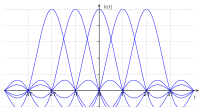
Photo from wikipedia
Physical layer wireless communications are more and more essential, and are vulnerable to malicious users owing to the nature of broadcast channels. Herein, we consider a centralized multi-channel cognitive radio… Click to show full abstract
Physical layer wireless communications are more and more essential, and are vulnerable to malicious users owing to the nature of broadcast channels. Herein, we consider a centralized multi-channel cognitive radio network in the presence of eavesdroppers (EVEs). In the network, the secondary base station (SBS) shares currently free primary channels to simultaneously communicate with secondary users (SUs), while passive eavesdroppers attempt to overhear data in the secondary communications. Each limited-battery SU is equipped with two antennas (one for transmitting signals, and other for receiving signals) and is powered by a solar energy harvester. Meanwhile, the SBS equipped with multiple antennas can operate in full-duplex (FD) transmission mode (simultaneously transmit and receive signals) or in half-duplex (HD) transmission mode (transmit and receive signals in turn during each half of a time slot) with the SUs. In this paper, we propose a novel scheme to maximize the secondary system security of the multi-channel cognitive system in the presence of multiple passive EVEs, in which the EVEs are able to overhear the data of the SBS−SU transmissions on all the primary channels. The problem of decision making is formulated as the framework of a partially observable Markov decision process (POMDP), and an optimal solution is achieved by adopting value iteration−based dynamic programming. Specifically, in each time slot, the SBS allocates optimal channel and optimal action (i.e. either stay silent or employ HD/FD transmission modes with optimal transmission power) for each SU in order to obtain maximum long-term secrecy rate for the secondary system.
Journal Title: IEEE Sensors Journal
Year Published: 2020
Link to full text (if available)
Share on Social Media: Sign Up to like & get
recommendations!